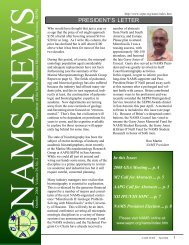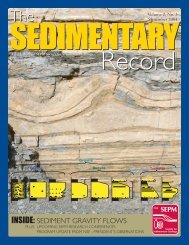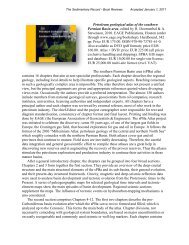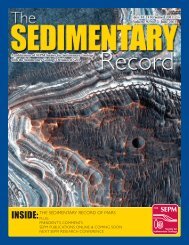PDF of contents and abstracts - SEPM
PDF of contents and abstracts - SEPM
PDF of contents and abstracts - SEPM
Create successful ePaper yourself
Turn your PDF publications into a flip-book with our unique Google optimized e-Paper software.
PALEOCLIMATIC APPLICATIONS AND MODERN PROCESS STUDIES OF<br />
PEDOGENIC SIDERITE<br />
GREG A. LUDVIGSON<br />
Kansas Geological Survey, The University <strong>of</strong> Kansas, 1930 Constant Avenue, Lawrence,<br />
Kansas 66047-3724, USA<br />
e-mail: gludvigson@kgs.ku.edu<br />
LUIS A. GONZÁLEZ, DAVID A. FOWLE, AND JENNIFER A. ROBERTS<br />
Department <strong>of</strong> Geology, The University <strong>of</strong> Kansas, 1475 Jayhawk Boulevard, Room 120,<br />
Lawrence, Kansas 66045-7594, USA<br />
STEVEN G. DRIESE<br />
Department <strong>of</strong> Geology, Baylor University, One Bear Place #97354, Waco,<br />
Texas 76798-7354, USA<br />
MARK A. VILLARREAL AND JON J. SMITH<br />
Kansas Geological Survey, The University <strong>of</strong> Kansas, 1930 Constant Avenue, Lawrence, Kansas<br />
66047-3724, USA<br />
AND<br />
MARINA B. SUAREZ<br />
Department <strong>of</strong> Geological Sciences, University <strong>of</strong> Texas at San Antonio, 1 UTSA Circle,<br />
San Antonio, Texas 78249, USA<br />
ABSTRACT: Pedogenic siderite is a carbonate mineral that forms in the reducing groundwaters <strong>of</strong> poorly<br />
drained soils <strong>and</strong> paleosols in zonal climatic belts with strongly positive precipitation–evaporation<br />
balances. Microcrystalline <strong>and</strong> spherulitic forms <strong>of</strong> siderite are commonly recognized in<br />
micromorphologic studies <strong>of</strong> hydromorphic paleosols. Ancient paleosol sphaerosiderites commonly occur<br />
with diameters in excess <strong>of</strong> 1 mm, while modern pedogenic siderite crystal dimensions in excess <strong>of</strong> 100<br />
µm are rare. Pedogenic siderites have been widely reported from Late Paleozoic, Mesozoic, <strong>and</strong> Cenozoic<br />
paleosols. The carbon <strong>and</strong> oxygen isotopic compositions <strong>of</strong> pedogenic siderites have been widely used as<br />
proxies for the oxygen isotopic composition <strong>of</strong> paleoprecipitation for their respective paleosols. Modern<br />
process studies <strong>of</strong> historic pedogenic siderites are yielding a more refined underst<strong>and</strong>ing <strong>of</strong> the stable<br />
isotopic systematics <strong>of</strong> low-temperature siderite. These works will lead to a future change in usage <strong>of</strong><br />
published siderite–water 18 O fractionation equations.






